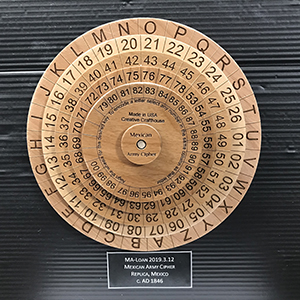Renaissance to revolution
The period following the invention of Alberti’s cipher wheel (c.16th-19th centuries AD) is marked by the development of complex monoalphabetic and polyalphabetic ciphers and ciphering machines. Distinct contributions to cryptology in this period were made in Germany (Trimethius 1516), England (Phelippes 1586/7), France (Vignere 1586, Rissignols 1626), America (Jefferson 1795, Morse 1844, Stager 1860s), and Mexico (Revolutionary Armies 1913). This section of the exhibition notes three developments in particular: The Trimethius Tableau with Vigenere’s Autokey, the Mexican Army Cipher Wheel, and the cryptographic origins of Braille
Trimethius Tableau
16th century AD
In 1516 Johannes Trimethius invented the tableau, a table of 26 columns and rows that uses a Caesar shift of one letter in each row. Trimethius encoded messages using the 1st row for the 1st letter, 2nd row for the 2nd letter, etc. In 1586 Vigenere improved this system by using the letters of a key to randomise the rows selected.
For example, the rows starting with the letters of the key “classics” (shown in red) are used in the same order as they appear in the key. The message letter is always found in the top row; the cipher letter by scanning down the column from the message letter until it intersects with the key row.
Download the Trimethius Tableau (PDF)
Can you encrypt this message?

Download a text version here - Renaissance codebreaker question (PDF).
Mexican Cipher Wheel
19th-20th centuries AD

During the Mexican-American War (1846-1848) and Mexican Revolution (1913-1917), the Mexican Army used ciphers, including a cipher wheel like the one in this exhibition. This cipher wheel consists of 5 rotatable discs. The outer disc contains the letters of the alphabet. The four inner wheels contain a series of double-digit numbers. By aligning the rotating discs according to a pre-chosen key, the cipher wheel assigns up to 4 numbers to each letter. For example: the key chosen could be E:11:33:66:99. This is programmed into the cipher wheel by rotating the discs to align the numbers 11, 33, 66 and 99 with the letter E. Once this is done all the other letters also have up to 4 numbers assigned to them. For instance, the letter Y has been assigned the numbers 05:27:60:93. Like the Alberti Cipher, the Mexican Army Cipher is polyalphabetic because it assigns more than one symbol to each letter of the alphabet. To defeat frequency analysis, all an encoder needed to do was randomly select one of the possible four numbers assigned to each letter when encoding. For example: using the key E:11:33:66:99, the word “eye” can be encoded as “11:05:33” or “11:27:33” or “11:60:66” or “11:93:99” or “66:05:33” or “99:27:33” – and these do not exhaust the possible combinations. To add extra complexity, encoders and decoders could agree to change the encryption key to increase the number of two-digit numbers assigned to each letter within a message. Anyone who had the same cipher wheel and encryption keys could easily read the numbers associated with each letter. Anyone without either cipher wheel or encryption codes could not.
Can You Identify The Initial Key?
Look at the Mexican Cipher Disc shown.
Which cipher numbers have been assigned to the letter E?
Bonus fact: Braille
19th century AD

Braille (1829) was developed from Night Writing, a system of tactile dots invented in 1815 to allow soldiers in the French military to exchange coded messages without light or sound. Did you know that in the Braille alphabet the letter W is placed at the end? You can see this on the Braille Cipher shown in this exhibition.

